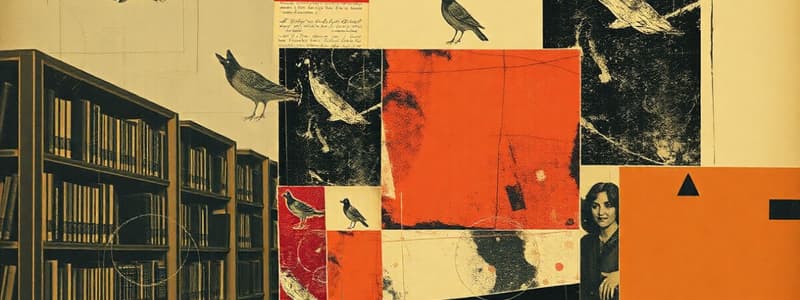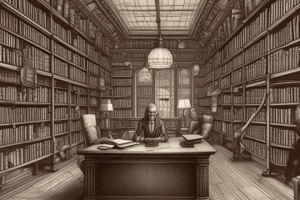Podcast
Questions and Answers
What is cataloguing in library science?
What is cataloguing in library science?
- The art and science of describing and listing materials for easy discovery (correct)
- The digitalization of all library materials
- The process of arranging books on shelves
- A system for borrowing books
Cataloguing consists of two main activities. What are they?
Cataloguing consists of two main activities. What are they?
- Library cataloguing and internet cataloguing
- Digital cataloguing and print cataloguing
- Descriptive cataloguing and subject cataloguing (correct)
- Fiction cataloguing and non-fiction cataloguing
What is the purpose of descriptive cataloguing?
What is the purpose of descriptive cataloguing?
- To classify materials according to their subjects
- To analyze the subject of the material
- To rank materials by popularity
- To describe the physical attributes of a material (correct)
What is the primary function of a library catalogue?
What is the primary function of a library catalogue?
According to Cutter (1876/1904), what is one key purpose of a catalogue?
According to Cutter (1876/1904), what is one key purpose of a catalogue?
What type of catalogue lists books available in multiple libraries?
What type of catalogue lists books available in multiple libraries?
What is a major function of subject cataloguing?
What is a major function of subject cataloguing?
Which of the following is NOT an advantage of a catalogue?
Which of the following is NOT an advantage of a catalogue?
What is original cataloguing?
What is original cataloguing?
What is copy cataloguing?
What is copy cataloguing?
Which of the following is an example of a bibliographic utility?
Which of the following is an example of a bibliographic utility?
What is a major challenge faced by cataloguers today?
What is a major challenge faced by cataloguers today?
The Integrated Library System (ILS) includes which cataloguing functions?
The Integrated Library System (ILS) includes which cataloguing functions?
Which type of cataloguing describes the physical and bibliographic attributes of an item?
Which type of cataloguing describes the physical and bibliographic attributes of an item?
What is a dictionary catalogue?
What is a dictionary catalogue?
What is a classification system used for?
What is a classification system used for?
Which cataloguing activity assigns call numbers to materials?
Which cataloguing activity assigns call numbers to materials?
What does OPAC stand for?
What does OPAC stand for?
How do cataloguers determine user needs when designing catalogues?
How do cataloguers determine user needs when designing catalogues?
Why is cataloguing important in modern libraries?
Why is cataloguing important in modern libraries?
The two main types of cataloguing are _______ and _______.
The two main types of cataloguing are _______ and _______.
_______ cataloguing focuses on the physical description of materials.
_______ cataloguing focuses on the physical description of materials.
The process of assigning subject headings to materials is called _______.
The process of assigning subject headings to materials is called _______.
A _______ is a list of materials in a library, arranged systematically.
A _______ is a list of materials in a library, arranged systematically.
_______ is a system for organizing books on shelves based on subject.
_______ is a system for organizing books on shelves based on subject.
Cataloguing is no longer necessary in modern libraries.
Cataloguing is no longer necessary in modern libraries.
A catalogue helps users find books by title, author, or subject.
A catalogue helps users find books by title, author, or subject.
Descriptive cataloguing focuses on classifying books.
Descriptive cataloguing focuses on classifying books.
Subject cataloguing helps users find materials based on topic.
Subject cataloguing helps users find materials based on topic.
Copy cataloguing does not require professional judgment.
Copy cataloguing does not require professional judgment.
Flashcards
Catalogue Records Creation
Catalogue Records Creation
Modifying and creating catalogue records from external sources.
WorldCat
WorldCat
A global catalog of library collections.
Balancing Descriptions
Balancing Descriptions
Maintaining balance between detail in descriptions and time limits.
Library Operations
Library Operations
Signup and view all the flashcards
Descriptive Cataloguing
Descriptive Cataloguing
Signup and view all the flashcards
Combined Catalogue
Combined Catalogue
Signup and view all the flashcards
Organizing Books
Organizing Books
Signup and view all the flashcards
Subject Cataloguing
Subject Cataloguing
Signup and view all the flashcards
Online Public Access Catalogue
Online Public Access Catalogue
Signup and view all the flashcards
User Surveying
User Surveying
Signup and view all the flashcards
Resource Location
Resource Location
Signup and view all the flashcards
Study Notes
Multiple Choice Questions
- Cataloguing in library science: The art and science of describing and listing materials for easy discovery.
- Cataloguing activities: Descriptive cataloguing and subject cataloguing.
- Descriptive cataloguing purpose: To describe the physical attributes of a library material.
- Library catalogue purpose: To enable users to find materials.
- Catalogue key purpose (Cutter): To help users find books by author, title, or subject.
- Catalogue type for multiple libraries: Union catalogue.
- Subject cataloguing function: Assigning call numbers to materials.
- Original cataloguing: Creating a new catalogue record from scratch.
- Copy cataloguing: Creating catalogue records from an external source with modifications.
- Bibliographic utility example: WorldCat
- Major challenge for cataloguers: The balance between detailed descriptions and time constraints.
Fill in the Blank
- Two main types of cataloguing: Descriptive cataloguing and subject cataloguing.
- Cataloguing focusing on physical description: Descriptive cataloguing.
- Process of assigning subject headings: Subject cataloguing.
- List of materials in a library: Catalogue.
- Organization system for books: Classification.
Key Term Definitions
- Catalogue: A structured list of materials in a library.
- Descriptive cataloguing: Describing the physical and bibliographic details of a material.
- Subject cataloguing: Assigning subject headings to materials.
- Copy cataloguing: Using an existing catalogue record with modifications.
- Union catalogue: A catalogue listing materials from multiple libraries.
True/False
- Cataloguing's necessity in modern libraries: False (cataloguing is still important).
- Catalogue's function for users: True (helps locate resources by author, title, or subject).
- Descriptive cataloguing classification focus: False (it describes, not classifies).
- Subject cataloguing for topic-based searching: True.
- Copy cataloguing and professional judgment: False (it requires professional judgment).
Studying That Suits You
Use AI to generate personalized quizzes and flashcards to suit your learning preferences.




